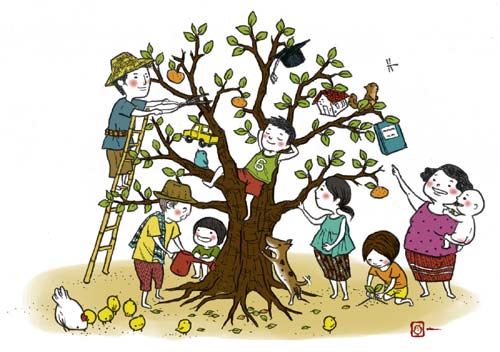當(dāng)前位置: Language Tips> 英語學(xué)習(xí)專欄
分享到
自人類誕生之日起,樹木就一直忠實(shí)地陪伴著我們。年復(fù)一年的生息輪回中,除了年輪的增長,我們似乎很難察覺樹木所經(jīng)歷的改變。然而,我們的這些老朋友在全球氣候急劇變化的今天卻遭遇了前所未有的困境。

By Randy Rieland
經(jīng)緯 選 張濤 譯
|
Trees have been one of the most stable and reliable companions of human beings since the very beginning. They sprout in the spring and their leaves fall in the autumn, and we know the cycle will start all over again next year, being one of the truer things in modern life. I mean, what’s more reliable than an oak? But scientists will tell you that, like the oceans, the world’s trees are going through some serious changes, and not in a good way. For example, consider the impact of the drought that’s been desiccating America’s Southwest. The Texas A&M Forest Service issued a damage report in last September: More than 300 million trees died in Texas forests alone as a result of the 2011 drought. It killed another 5.6 million trees in Texas cities. Then a study published in Nature Climate Change in last October concluded that if current climate trends continue, forests in the Southwest will die out at an accelerating rate. And not just from rising temperatures and lack of rain, but also from invasions of tree-eating pests and more destructive forest fires, also tied to climate change. By analyzing forest fire data from satellites for the past 30 years in parallel with data on tree ring growth over the same period, the researchers were able to see a “strong and exponential” relationship between droughts and the number of acres of forests wiped out by wildfires. Park Williams, a scientist at the Los Alamos National Laboratory in New Mexico and lead author of the study notes: “This suggests that if drought intensifies, we can expect forests not only to grow more slowly, but also to die more quickly.” Computer models suggest that for 80% of the years in the second half of the 21st century, America’s Southwest will suffer through what the study describes as “mega -drought.” In the spirit of giving trees more than a seasonal glance, here are eight other things scientists have learned about them in 2012. 1. Forest fires have become more intense and harder to control. One big factor is the rising frequency of what are known as “blowdowns.” With violent storms with strong winds occurring more often, whole sections of forests are toppling over, creating, in essence, giant campfires awaiting a spark. 2. The death of forests could double the number of big floods. A study at the University of British Columbia concluded that faster snow melts due to fewer trees creating shade will not only increase the size of floods, but could also make the really big ones happen more often. 3. Sick trees could be boosting greenhouse gas levels. Scientists at Yale University found that diseased trees can carry very high levels of methane, one of the more potent greenhouse gases. Although they appear healthy, many old trees—between 80 and 100 years old—are being hollowed out by a fungal infection that slowly eats through the trunk, creating a nice home for methane-producing micro-organisms. 4. NASA technology could help save trees that look risky. The space agency is using high-tech cameras to create 3-D images of trees, a process that will help experts get a better idea of where a tree is likely to crack and how it might come down. Ideally, this could help save trees that arborists now would probably cut down. 5. Will it be smarter to grow smaller trees? Scientists at Oregon State University think so. They believe it will make sense to grow genetically-modified “semi-dwarf” trees in the future to make them better suited for drier climates and as a source of bio-energy. 6. Slow down on the maple syrup. The U.S. Forest Service says that climate change is likely to diminish production of maple syrup later this century. The reason? Habitats suitable for maple trees are expected to shrink. 7. Fossilized forests could come back to life. Forests in the Canadian Arctic that last were alive more than 2.5 million years ago could be revitalized by climate change, according to a University of Montreal scientist. Alexandre Guertin-Pasquier says that, according to climate change forecasts, temperatures could rise to levels similar to when willow, pine and spruce trees thrived in now snow-covered places such as Bylot Island. 8. Good trees make good neighbors? Studies in three American cities–Baltimore, Philadelphia and Portland, Ore.–concluded that urban neighborhoods with more trees tend to have lower crime rates. While no researcher would go so far as to say that trees reduce crime, they did find a “very strong association” between more tree canopy and less crime. |
從古至今樹木都是人類最忠實(shí)、最可靠的伙伴。它們?cè)诖喝胀卵俊⑶锶章淙~,每一年都會(huì)迎來新的輪回,它們是現(xiàn)代社會(huì)最為真實(shí)的風(fēng)景之一。你說,還有什么能比一棵橡樹更值得人信賴呢?然而,科學(xué)家們會(huì)告訴你,世間的樹木就像海洋一樣,正經(jīng)歷著一些翻天覆地的變化,但這并不是什么好事。 例如,讓我們看看美國西南部地區(qū)的旱災(zāi)對(duì)樹木造成的影響。得克薩斯州A&M林務(wù)局于去年九月發(fā)布了旱災(zāi)損失情況報(bào)告:僅得克薩斯州林區(qū)里就有三億多株樹木死于2011年的旱災(zāi)。旱災(zāi)還導(dǎo)致了得克薩斯州各城市中560萬株樹木死亡。 隨后,一篇于去年十月在《自然氣候變化》雜志上發(fā)表的研究報(bào)告指出,如果目前的氣候變化趨勢持續(xù)下去,美國西南部的森林將以更快的速度消失。氣溫升高、降雨匱乏,還有啃噬樹木的害蟲入侵,以及毀滅性的森林大火,這些都與氣候變化不無關(guān)系。 通過對(duì)比分析過去30年里衛(wèi)星記錄的森林大火數(shù)據(jù)以及同時(shí)期樹木年輪生長情況的數(shù)據(jù),研究者們得以發(fā)現(xiàn)干旱與被大火吞噬的森林面積之間存在著一個(gè)強(qiáng)勁的正向關(guān)系,且增長速度越來越快。 作為新墨西哥州洛斯阿拉莫斯國家實(shí)驗(yàn)室的一名科學(xué)家,同時(shí)也是該研究報(bào)告的第一作者,帕克?威廉姆斯指出:“這表明如果干旱加劇,我們不但會(huì)發(fā)現(xiàn)森林的生長速度放緩,更會(huì)目睹其加速死亡。”計(jì)算機(jī)模型顯示,在本世紀(jì)下半葉80%的年份里,美國西南部將遭受如該研究報(bào)告所描述的“超級(jí)旱災(zāi)”。 除了季節(jié)性因素外,我們希望能從更多的方面研究樹木,以下是2012年科學(xué)家們關(guān)于樹木的八大發(fā)現(xiàn),讓我們一起來看看。 1. 森林大火破壞性越來越大并難以控制。 (導(dǎo)致此現(xiàn)象的)一個(gè)重要因素是所謂“被刮倒的樹木”越來越多。強(qiáng)烈的暴風(fēng)雨伴隨著大風(fēng)的天氣越來越常見,整塊森林都會(huì)被吹倒,這時(shí)如果稍有一絲火星,就會(huì)引起巨大的“森林篝火”。 2. 森林的死亡會(huì)加劇洪水的泛濫。 不列顛哥倫比亞大學(xué)的一項(xiàng)研究顯示,樹木的減少意味著樹陰的減少,樹陰的減少會(huì)導(dǎo)致積雪的融化速度加快,這不僅會(huì)使得洪水的水量增大,還會(huì)讓特大洪水更為頻繁地發(fā)生。 3. 患病的樹木會(huì)釋放更多的溫室氣體。 耶魯大學(xué)的科學(xué)家們發(fā)現(xiàn)患病的樹木會(huì)釋放含量很高的甲烷——導(dǎo)致溫室效應(yīng)的主要?dú)怏w之一。盡管許多樹齡在80到100歲之間的樹木看起來很健康,但是它們的樹干已被真菌慢慢侵蝕掏空,成為了滋生微生物的溫床,而這些微生物能夠釋放出大量的甲烷。 4. 美國國家航空航天局的技術(shù)能拯救瀕危的樹木。 該機(jī)構(gòu)正在使用高科技照相機(jī)為樹木制作3D影像。這一舉措能幫助林業(yè)專家更好地熟悉樹木的那些部分容易斷裂,以及樹木會(huì)如何倒下。理想情況下,這項(xiàng)技術(shù)能夠拯救那些可能會(huì)被育樹專家們砍掉的樹木。 5. 種植小型樹木更為明智嗎? 俄勒岡州立大學(xué)的科學(xué)家們正是這樣認(rèn)為的。他們相信,未來種植經(jīng)過基因改良的“半矮”型樹木是非常明智的,這樣的樹木能更好地適應(yīng)干旱氣候并成為生物能源的來源之一。 6. 楓糖漿產(chǎn)量會(huì)下降。 美國國家林務(wù)局稱,本世紀(jì)后期,氣候變化很可能會(huì)導(dǎo)致楓糖漿減產(chǎn)。究其原因:適合楓樹生長的林地正在逐漸減少。 7. 石化森林可能會(huì)復(fù)活。 蒙特利爾大學(xué)的一名科學(xué)家亞歷山大?蓋爾丹?帕斯奎認(rèn)為,曾在二百五十多萬年前生長于加拿大北極圈內(nèi)的古代森林或因氣候變化而復(fù)活。他指出,根據(jù)對(duì)氣候變化的預(yù)測,在如拜洛特島那樣被冰雪覆蓋的地區(qū),氣溫可能升高到適于柳樹、松樹和云杉等樹種生長的程度。 8. 良好的樹木覆蓋率能創(chuàng)造良好的鄰里關(guān)系? 對(duì)美國三座城市——巴爾的摩、費(fèi)城以及俄勒岡州波特蘭市的研究表明,城市社區(qū)樹木越多,犯罪率越低。沒有哪位研究者敢斷言樹木能降低犯罪率,但他們確實(shí)發(fā)現(xiàn)高森林覆蓋率和低犯罪率之間存在著“非常明顯的關(guān)聯(lián)性”。 (來源:英語學(xué)習(xí)雜志 編輯:丹妮) |
|
Vocabulary: 1. sprout: (植物)發(fā)芽,抽芽。 2. drought: 干旱,旱災(zāi);desiccate: 使變干,使干涸。 3. die out: 絕跡,滅絕;accelerate: 加快,加速。 4. pest: (毀壞莊稼或植物的)小動(dòng)物,害蟲;tie to: 與……有聯(lián)系,與……相關(guān)聯(lián)。 5. in parallel with: 與……同時(shí),與……平行;tree ring: (樹木的)年輪;exponential: 越來越快的增長、增加;wipe out: 徹底毀滅,抹去。 6. mega: 巨大的,龐大的。 7. in the spirit of: 本著……的精神。 8. topple over: 倒塌,傾覆;spark: 火花。 9. melt: n. 融化。 10. boost: 促進(jìn),推動(dòng)。 11. methane: 甲烷;potent: 效力大的,強(qiáng)效的。 12. hollow: 把……挖空,使成中空;fungal: 真菌的,由真菌引起的;infection: 感染。 13. maple syrup: 楓糖漿,由楓樹木質(zhì)部汁液熬制成的糖漿。 14. diminish: 減少,減小。 15. habitat: (動(dòng)植物的)生活環(huán)境,自然棲息地。 16. fossilize: (使)成化石,石化。 17. canopy: 遮蓋,覆蓋。 |
上一篇 : 貝多芬的陰謀
下一篇 : 艾瑪?沃森:打破“赫敏”魔咒
分享到
關(guān)注和訂閱


關(guān)于我們 | 聯(lián)系方式 | 招聘信息
電話:8610-84883645
傳真:8610-84883500
Email: languagetips@chinadaily.com.cn